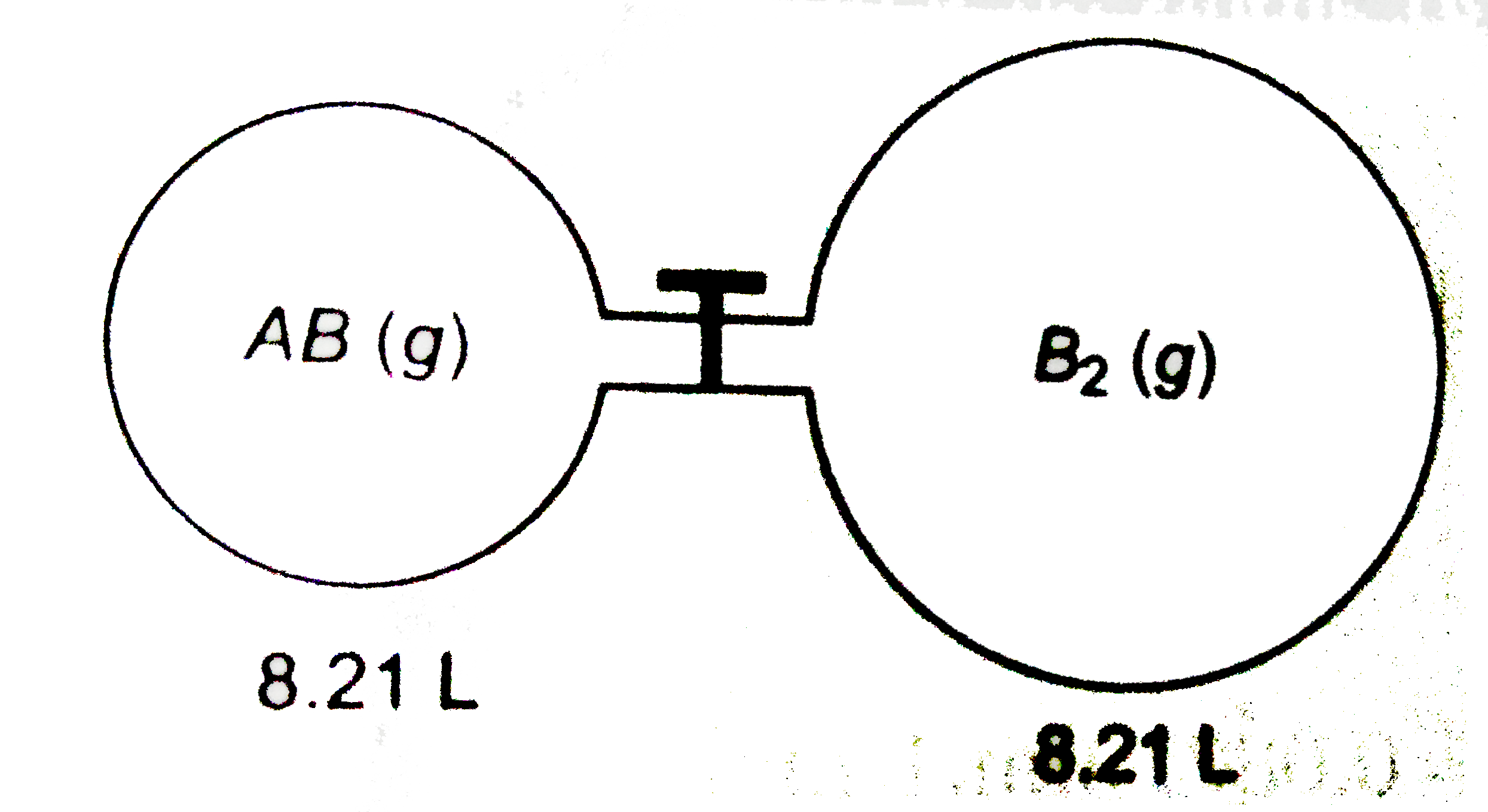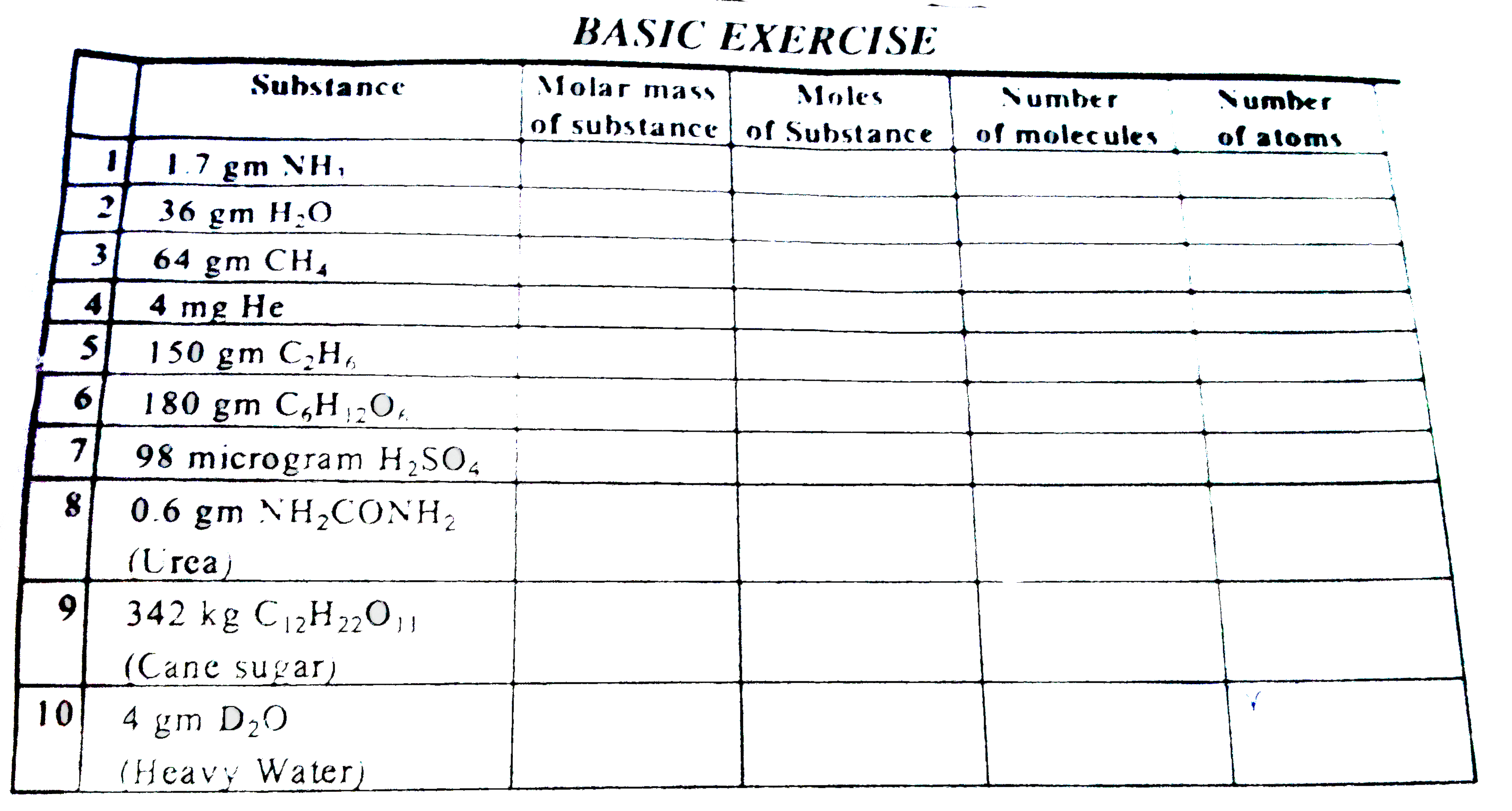At room temperature, the following reaction proceeds nearly to completion:
2NO+O2→2NO2→N2O4
The dimer, N2O4, solidfies at 262K. A 250mL flask and a 100mL flask are separated by a stopcock. At 300K, the nitric oxide in the larger flask exerts a pressure of 1.053atm and the smaller one contains oxygen at 0.789atm. The gase are mixed by opening the stopcock and after the end of the reaction the flasks are cooled to 220K. Neglecting the vapour pressure of the dimer, find out the pressure and composition of the gas remaining at 220K. (Assume the gases to behave ideally)
To solve the problem step-by-step, we will follow the outlined approach based on the information given in the question.
Step 1: Calculate the moles of NO and O2 in their respective flasks.
For NO in the 250 mL flask:
- Given: Pressure (P) = 1.053 atm, Volume (V) = 250 mL = 0.250 L, Temperature (T) = 300 K
- Using the ideal gas equation: PV=nRT
nNO=PVRT=(1.053atm)×(0.250L)(0.0821L atm K−1mol−1)×(300K)
Calculating this gives:
nNO=0.2632524.63≈0.01069mol
For O2 in the 100 mL flask:
- Given: Pressure (P) = 0.789 atm, Volume (V) = 100 mL = 0.100 L, Temperature (T) = 300 K
nO2=PVRT=(0.789atm)×(0.100L)(0.0821L atm K−1mol−1)×(300K)
Calculating this gives:
nO2=0.078924.63≈0.00320mol
Step 2: Determine the limiting reagent and the moles of products formed.
The reaction is:
2NO+O2→2NO2
From the stoichiometry of the reaction:
- 2 moles of NO react with 1 mole of O2.
Using the moles calculated:
- Moles of O2 = 0.00320 mol (limiting reagent)
- Moles of NO required = 2×nO2=2×0.00320=0.00640mol
Step 3: Calculate the remaining moles of NO after the reaction.
Initial moles of NO = 0.01069 mol
Moles of NO used = 0.00640 mol
Remaining moles of NO:
nNO,remaining=nNO,initial−nNO,used=0.01069−0.00640=0.00429mol
Step 4: Calculate the total pressure after cooling to 220 K.
Total volume of the combined flasks = 250 mL + 100 mL = 350 mL = 0.350 L
Using the ideal gas law for the remaining NO at 220 K:
PNO=nRTV
Substituting the values:
PNO=(0.00429mol)×(0.0821L atm K−1mol−1)×(220K)0.350L
Calculating this gives:
PNO=0.07790.350≈0.222atm
Final Answer:
- The pressure exerted by the remaining gas (NO) at 220 K is approximately 0.222 atm.
- Composition of the gas remaining is primarily NO, as O2 is the limiting reagent and has been completely consumed.
- Given: Pressure (P) = 1.053 atm, Volume (V) = 250 mL = 0.250 L, Temperature (T) = 300 K
- Using the ideal gas equation: PV=nRT
nNO=PVRT=(1.053atm)×(0.250L)(0.0821L atm K−1mol−1)×(300K)
- Given: Pressure (P) = 0.789 atm, Volume (V) = 100 mL = 0.100 L, Temperature (T) = 300 K
- 2 moles of NO react with 1 mole of O2.
- Moles of O2 = 0.00320 mol (limiting reagent)
- Moles of NO required = 2×nO2=2×0.00320=0.00640mol
- The pressure exerted by the remaining gas (NO) at 220 K is approximately 0.222 atm.
- Composition of the gas remaining is primarily NO, as O2 is the limiting reagent and has been completely consumed.
Topper's Solved these Questions
- BOOK - CENGAGE CHEMISTRY ENGLISHCHAPTER - STATES OF MATTEREXERCISE - Ex 5.115videos
STATES OF MATTER
- BOOK - CENGAGE CHEMISTRY ENGLISHCHAPTER - STATES OF MATTEREXERCISE - Ex 5.216videos
STATES OF MATTER
- BOOK - CENGAGE CHEMISTRY ENGLISHCHAPTER - STATES OF MATTEREXERCISE - Archives (Integer)1videos
STATES OF MATTER
- BOOK - CENGAGE CHEMISTRY ENGLISHCHAPTER - SOME BASIC CONCEPTS AND MOLE CONCEPTEXERCISE - Archives Subjective11videos
SOME BASIC CONCEPTS AND MOLE CONCEPT
- BOOK - CENGAGE CHEMISTRY ENGLISHCHAPTER - STOICHIOMETRYEXERCISE - Archives Subjective33videos
STOICHIOMETRY
Similar Questions
At room temperature following traction goes to completion
2AB(g)+B2(g)→2AB2(s)
AB2 is solid with negligble vapour pressure below 0∘C. At 300 K, the AB in the smaller flask exerts a pressure of 3 atm and in the larger flask B2 exerts a pressure of 1 atm at 400 K when they are separated out by a close valve, The gases are mixed by opening the stop cock and after the end of the reaction the flask are cooled to 250 K

The final pressure is :View Solution48 g of oxygen and 4 g of hydrogen are placed in 2 litre flask at 0∘C. Find the total pressure in atm of the gas mixture.
View SolutionA gaseous mixture containing 8g of O2 and 227 mL of N2 at STPis enclosed in flask of 5 L capacity at 0∘C. Find the partial pressure of each gas and calculate the total pressure in the vessel.
View SolutionA gaseous mixture containing 0.35g of N2 and 5600 ml of O2 at STP is kept in a 5 litres flask at 300K. The total pressure of the gaseous mixture is
View SolutionTwo gases in adjoining vessels were brought into correct by opening a stopcock between them. The one vessel measured 0.25L and contained NO gas at 800 torr and 220K, the other measured 0.1L contained O2 gas at 600 torr and 220K. The reaction to form N2O4(s) exhausts the limiting reagent completely,
(a) Neglacting the vapour pressure of N2O, what is the pressure of the gas remaining at 220K after complection of the reaction?
(b) What weight of N2O is formed?View SolutionA flask contains three times as many moles of H2 gas as it does O2 gas. If hydrogen and oxygen are the only gases present, what is the total pressure in the flask if the partial pressure due to oxygen is P?
View SolutionIf 200mL of He at 0.66 atm and 400 mL of O2 at 0.52 atm pressure are raised in 400 mL vessel at 20∘C then find the partial pressures of He and O2 ?
View SolutionA sample of O2 is at a pressure of 1 atm when the volume is 100ml and its temperature is 27C .what will be the temperature of the gas if the pressure becomes 2 atm and volume remains 100 ml.
View Solution2gm of 'He' exerts a pressure of 2 atmospheres in a rigid flask. How many grams of H2 should be pumped into the flask such that the pressure raises to 4 atm
View Solution
A flask of 8.21 litre contains CH4 gas at a pressure of 2 atm. Find moles of CH4 gas at 400 K?View Solution

